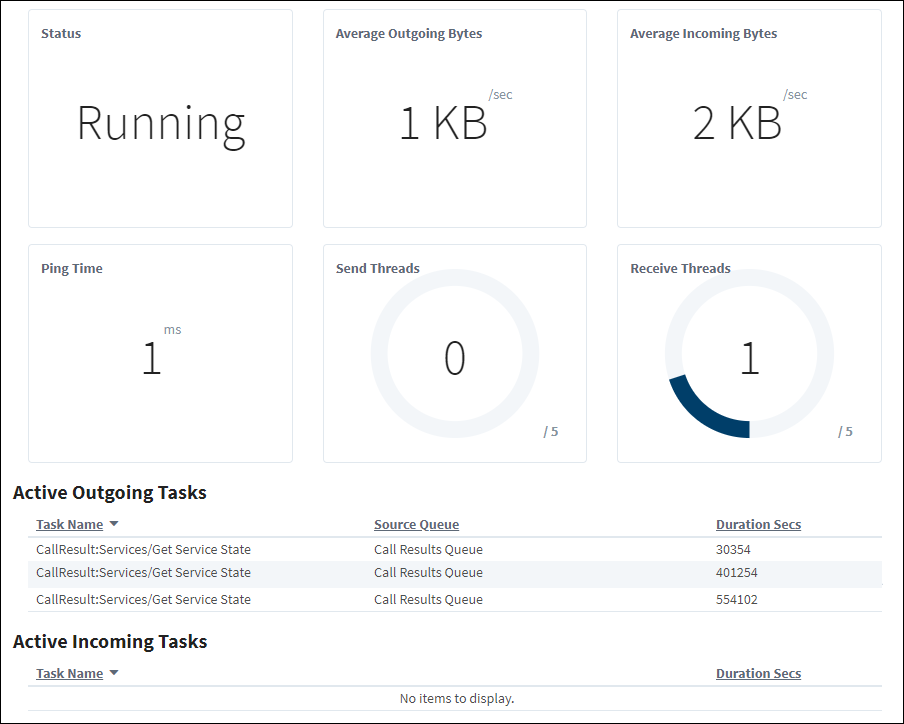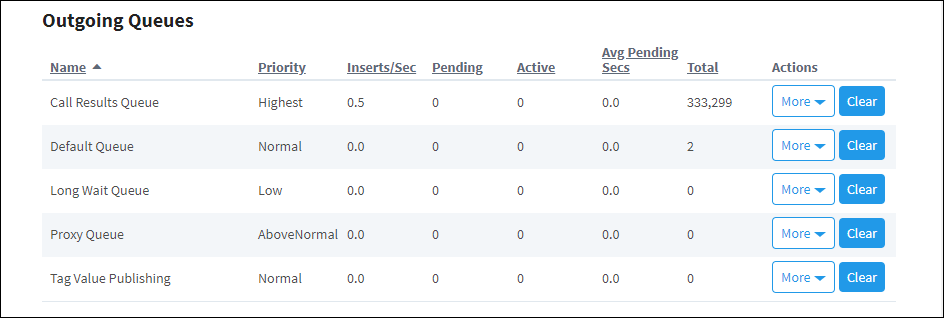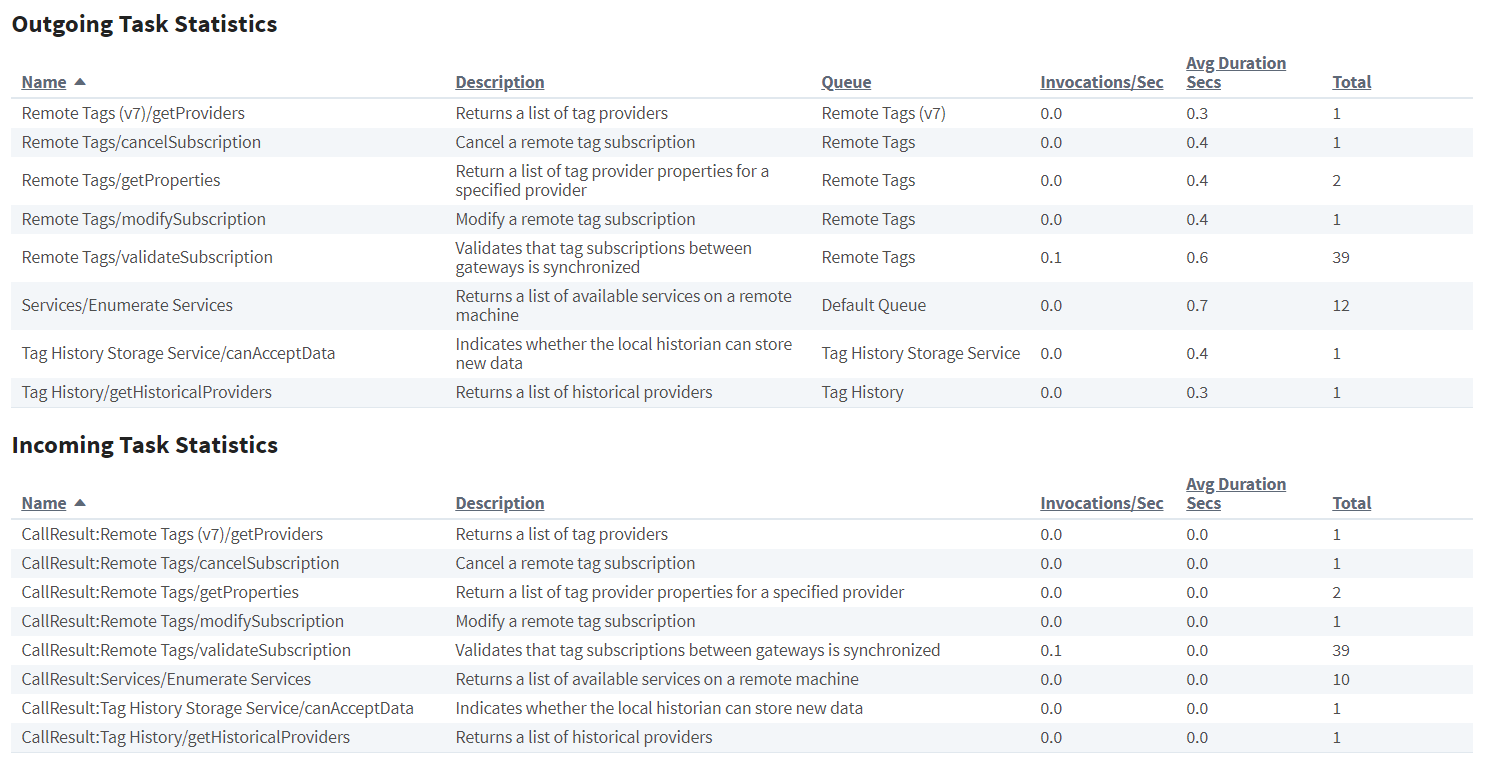Gateway Network Connection Details
Gateway Network Connection Details
Ignition's Gateway Network system shares information across Gateways using threads to send and receive information. For example, if you have a Remote Tag Provider configured between Gateway A and Gateway B, messages containing live tag information will be sent between these two Gateways using threads to send and receive live tag data. Similarly, a Remote Historical Tag Provider will send/receive messages with historical tag data between Gateway A and Gateway B using this same set of threads. Each Ignition sub system that uses the Gateway Network will utilize these threads in some way.
Ignition's Gateway Network also has a queue associated with each Ignition subsystem. These queues allow for Ignition to have a way to prioritize which sub system should have access to a send or receive thread. Prioritization here is especially important because if all send threads are in use, messages cannot be sent between two Gateways. The Gateway Network page includes additional information that will help better monitor Gateway interactions.

The image above shows the basic Gateway Network Connection Status page where we can see there is an outgoing Gateway Network connection from Gateway A to Gateway B. Pressing the Details button will bring up detailed information about this connection as below:

| Attribute | Description |
|---|---|
| Status | Current state of the Gateway Network Connection. |
| Average Outgoing Bytes | Average bytes of data going from the Local Gateway to the Remote Gateway per second. |
| Average Incoming Bytes | Average bytes of data going from the Remote Gateway to the Local Gateway per second. |
| Ping Time | Reaction time of Gateway connection. How fast you get a response after you've sent out a request. |
| Active | Number of messages being actively processed by the Gateway network connection. |
| Send Threads | A thread that is used by the Gateway Network to upload messages from one Gateway to another. |
| Receive Threads | A thread that is used by the Gateway Network to download messages from one Gateway to another. |
| Local Id | Id of the local Gateway. |
| Remote Id | Id of the remote Gateway. |
| Remote Gateway | Name of the Gateway on the Gateway network. |
| Network Address | Physical address used to communicate with all devices on the Gateway network. |
| Redundant Role | The redundancy role of the Gateway. Can either be Independent, Backup, or Master. |
| Direction | The direction of the Gateway Network connection. Can either be Incoming or Outgoing. |
| Session Id | Gateway connection session Id number. Connected Gateways use the same session Id on both Gateways. |
| Last Comm | The time of the last communication with the Gateway. |
| Fault Count | Number of times the connection has faulted since the Gateway has been started. |
| Connection Events | Displays a list of recent connection events. |
Active Outgoing and Incoming Tasks List
| Attribute | Description |
|---|---|
| Task Name | Name of the task that is using a thread. |
| Source Queue | The Ignition sub system queue that dispatched this task. |
| Duration Secs | This is how long in seconds it takes for a task to be performed. |
Gateway Network Statistics
In addition to showing live thread and task information, users can also keep track of Gateway Network Statistics. By clicking on the Details button below, the Gateway Network Statistics Page appears for Gateway B:

Outgoing Queues
The Gateway Network Statistics page has three sections associated with it. First, the Outgoing Queues section. The Outgoing Queues section shows tasks that are both in a pending and active state. A pending task is a task that has not yet been dispatched to the Gateway Network thread pool. An active task is a task that is being processed by the Gateway Network thread pool and should show up under the Gateway Network Connection Status page as either an outgoing or incoming task.

| Attribute | Description |
|---|---|
| Name | Name of the queue. |
| Priority | Level of priority for a queue. |
| Inserts/Sec | Rate of task inserts per second for a queue |
| Pending | Number of pending tasks in a queue that have not yet been dispatched to a Send/Receive thread. |
| Active | Number of messages being actively processed by the Gateway Network connection. |
| Avg Pending Secs | Average number of seconds that a task has been pending in a queue. |
| Total | Total number of tasks executed from this queue. |
| Actions | Set of actions associated with a queue. Users can both Pause and Clear a queue. |
Temporary Queue Actions
The Gateway Network Statistics page has controls for pausing and clearing a queue. To pause a queue means no new tasks will be allowed to be inserted into the paused queue. To clear a queue means that all pending tasks will be purged. These actions are designed to help the user deal with a possibly overloaded Gateway Network connection due to a specific sub system flooding the queue with more tasks than the connection can handle. Note that neither of these actions will have any effect on active tasks, as they have already been dispatched to the Gateway Network connection and cannot be cancelled.

Outgoing and Incoming Tasks Statistics
The Outgoing and Incoming Task Statistics section shows individual tasks that have been processed by the Gateway Network Connection.

| Outgoing and Incoming Tasks Attributes | Description |
|---|---|
| Name | Name of a task. |
| Description | Description for a task. |
| Queue | Queue invoking a task (For Outgoing Tasks only) |
| Invocation/Sec | Rate at which a task is invoked per second. |
| Avg Duration Secs | Average duration in seconds of the time it takes for this task to execute. |
| Total | Number of times the task has been executed in total. |